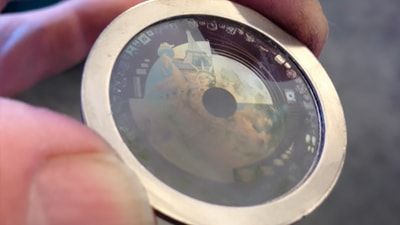What’s Inside this Artistic Capsule Headed to the Moon?
See how these artists captured a portrait of humanity in just six ounces
/https://tf-cmsv2-smithsonianmag-media.s3.amazonaws.com/filer/4e/c4/4ec447b9-efcf-4099-9525-22d4c0943b2a/moon_arts_853x480-min.jpg)
A small vial containing a drop of blood from 33 artists, a mixture of water from rivers around the world, text messages between a husband and wife, the fingerprints of a journalist and more samples of earthly existence are crammed into an eight-inch-tall capsule headed to the moon. It’s a work of art called the MoonArk, intended to serve as a portrait of humanity, reports Irina Zhorov for NPR.
The fingerprints are Zhorov's, which she brushed against the surface of one of the Ark’s outer aluminum shells during her reporting. “Your fingerprints are going to the moon,” Ark contributor Dylan Vitone told her. His piece, “Texts to Elaine,” are messages that he sent to his wife over a five-year period. He says he intends this addition as both a critique of “the way we broadcast our life” and as a sentimental celebration of the importance of their relationship.
The project, which is designed to last billions of years, serves as a meditation toward which artifacts humans choose to send up into space. “We think it should be different than sticking a flag in the soil and claiming territory ... maybe we're leaving breadcrumbs for someone else to find their way back here," says Mark Baskinger, another contributor, about the project. "It's an attempt to communicate forward in time—it's an attempt to communicate outward."
A team of about 30 artists, designers, scientists and engineers have been working on the Ark, led by Lowry Burgess, a space artist and professor at Carnegie Mellon University (CMU).
The capsule will catch its ride to the moon on the CMU Robotics Institute rover "Andy," which is competing for Google’s Lunar Xprize. The competition offers $30 million to the first privately funded team to successfully land a robot on the moon. As no non-government entity has yet to do this, there is no guarantee that the rover will succeed at making the approximately 238,000-mile journey. That being said, in December, the Xprize committee named the rover the winner of a Milestone Prize for meeting development benchmarks for flight readiness. The rover will explore for ice at the pole of the moon. Preparation have gone into the design of the Ark to ensure that it will be able to endure the trip and work under the extreme conditions of the surface of the moon.
In the Ark are elements representing “all the Arts and Humanities (art, architecture, design, music, drama, ballet, and poetry)—all engaging the most advanced sciences, engineering, technologies, and material science,” according to the project’s website. The team views not just the art but also the craft and science needed to create the lightweight materials to carry the art as part of the project.
Inside the capsule, there are four aluminum chambers that each represent a different theme: the Earth, the metasphere (the space between the Earth and the moon), the moon and ether (the space beyond the moon) to mark humanity's continued exploration into space. All of this is crammed into a sculpture that will weigh no more than half a can of soda, according to a press release.
The capsule will also hold the vial of mixed blood, river water and other projects. Paintings on metal foil and micro-etched sapphire disks will carry images of life on Earth, including a depiction of the migration patterns of arctic seabirds and humpback whales, reports Julie Albright for Carnegie Mellon Today. The Ark will contain animals, just as Noah’s did: Dried and preserved plankton collected from around the world will reside inside a cage-like structure titled “The Wanderers.” Jim Daniels, an English professor at CMU, has selected poems that feature the moon.

Though it might stay on the moon for a very long time before extraterrestrial visitors come, the project's creators believe that once it is found, the individuals will understand what it is.
“Anyone who survives a billion years and arrives on the moon will be pretty intelligent and will be able to figure out the project,” Burgess tells Albright.
The MoonArk is scheduled to launch in 2016.